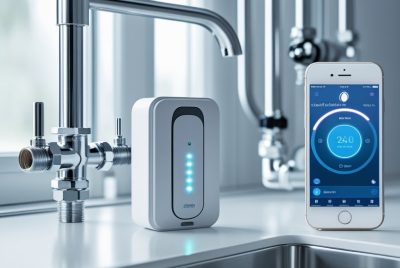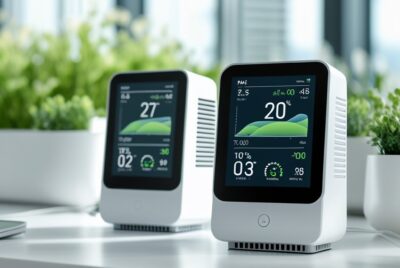Best Smart Home Hub: Seamless Integration
*We may earn a commission for purchases made using our links. Please see our disclosure to learn more.
Best Smart Home Hub: Top Picks for Seamless Connectivity
Smart homes are becoming increasingly ubiquitous, offering convenience and enhanced control of home environments. The cornerstone of this technology is the smart home hub, a device that acts as the central nervous system of a smart home setup. This hub connects various smart devices, from thermostats to lights, allowing them to communicate and be managed through a single interface. Due to its pivotal role, choosing the right smart home hub is crucial for a seamless integration of technology into daily life.
Selecting the best smart home hub requires consideration of several factors: compatibility with existing devices, user interface simplicity, and the level of customization available. The hub must support a wide range of protocols and brands to ensure that all your smart devices can connect without issues. Ease of use is also paramount, as the hub should provide a streamlined and intuitive experience that doesn’t overwhelm the user. Advanced users may also look for features that allow for automation and routines that suit their lifestyle.
When assessing smart home hubs, pay close attention to the ecosystem it’s designed to operate within. Some hubs are better suited to specific ecosystems, like Google Home or Amazon Alexa, while others offer broader compatibility. Look for a hub that not only aligns with your current devices but also leaves room for future smart home expansions. Connection stability, the speed of command execution, and the level of customer support provided by the manufacturer are also critical considerations.
I’ve dedicated time to researching and evaluating various smart home hubs to discern which models stand out in a crowded market. The result is a concise list that aims to simplify the selection process, ensuring you can optimize your smart home experience effectively.
Top Smart Home Hubs
In the ever-evolving world of home automation, I find it increasingly important to have a reliable smart home hub at the heart of the system. A smart home hub integrates various smart devices from different brands, allowing for centralized control and automation. The aim is to create a seamless and efficient smart home ecosystem. Here are my top picks for smart home hubs that stand out in their ease of use, compatibility, and functionality.
Aeotec Smart Home Hub
I’ve found the Aeotec Smart Home Hub to be an invaluable addition to my smart home setup for its broad compatibility and reliability.
Pros
- Simplifies control of various smart devices
- Supports voice control with popular assistants
- Maintains automation routines even during internet outages
Cons
- Initial setup requires internet
- Not compatible with devices outside North America
- Limited tech support for troubleshooting
Managing a smart home becomes much easier with a central control hub, and my experience with the Aeotec Smart Home Hub has brought this point home. The ability to streamline the control of over 5,000 devices from multiple brands under one app or voice assistant is a real game-changer. Instead of juggling various apps to turn on lights, adjust the thermostat, or monitor security cameras, this hub lets me do it all from a single interface.
Interoperability is the name of the game in smart homes, and this hub excels with its cross-protocol support for Zigbee, Z-Wave, Wi-Fi, and the new Matter standard. When I first connected it to my network, the seamless interaction between my Alexa-powered devices and my Z-Wave door locks was impressive. The convenience soared when I created automations that functioned even during an internet outage, offering peace of mind that my smart routines won’t skip a beat.
However, every product has its drawbacks. Setting up the Aeotec Hub involved a few steps that required a stable internet connection, and although it wasn’t complicated, it is something to consider for those without reliable internet. The region lock to North America can also be a limitation for some users who have, or plan to use, international devices. Additionally, I encountered a hiccup or two along the way that had me wishing for more robust customer support.
In summary, balancing my day-to-day tasks has become undoubtedly smoother with the Aeotec Smart Home Hub at the heart of my smart home system. From morning routines to nighttime security checks, the hub has facilitated a seamless connection and control experience that has left me more than satisfied.
Echo 4th Gen
I recently integrated the Echo 4th Gen into my home, and it’s become a central piece of my daily routine for both entertainment and smart home management.
Pros
- Delivers an immersive sound experience that easily fills the room
- Acts as a reliable smart home hub managing compatible devices effortlessly
- Stellar voice recognition capabilities with Alexa ready to assist at a moment’s notice
Cons
- Requires compatible devices for full smart home functionality
- May experience occasional hiccups in recognizing voice commands when music is playing loudly
- Limited to Alexa-compatible services for certain integrations
Getting started with the Echo was a breeze; setting it up felt almost intuitive. It serves not only as a speaker but as a command center for my home’s smart devices. Transitioning to voice-controlled lights and locks felt like stepping into the future. The convenience of asking Alexa to manage tasks, from setting timers to solving math problems, is something I can hardly do without now.
The sound quality really stands out, especially when playing my favorite albums. Whether I’m looking to relax with some classical music or get energized with the latest hits, the adaptive audio fills every corner with rich, detailed sound.
There is, however, room for improvement. I noticed that at high volume levels, Alexa can struggle to catch my commands, requiring a raised voice or a repeat. And for anyone who hasn’t invested in smart home devices or Alexa-compatible services, they might not get the full value the Echo offers.
Despite the minor issues, the Echo 4th Gen has added a level of convenience and enjoyment to my daily routine that has made it indispensable. When I come home and the lights turn on with just a simple command, it confirms I made the right choice with this smart hub.
Hubitat C-8 Pro
I recently set up the Hubitat C-8 Pro in my home and believe it’s a strong contender for those who value local processing and broad device compatibility.
Pros
- Local processing for speed and privacy
- Wide range of compatible devices and brands
- Matter, Zigbee, and Z-Wave protocol support
Cons
- Somewhat steep learning curve for new users
- Lacks more extensive customer support
- Compatibility issues with a few older Z-Wave devices
The moment I integrated the Hubitat C-8 Pro into my existing smart home setup, its local processing capability became apparent. Devices responded quickly to commands without the lag that sometimes plagues cloud-dependent hubs. I noticed a distinct improvement in the reliability of my smart sensors and automations. This is a game-changer for anyone who’s experienced delays or outages with other hubs.
As someone who enjoys tinkering with smart home configurations, I appreciated that the Hubitat C-8 Pro connects effortlessly with over a thousand devices from more than a hundred brands. Whether I was working with smart locks, lighting, or my HVAC system, compatibility was rarely an issue. This hub serves as an excellent central controller for a diverse and elaborate smart home.
I’ve been closely following the development of the Matter protocol, so it was crucial for me to choose a hub that’s Matter compatible. The Hubitat C-8 Pro not only fulfilled this requirement but also increased the versatility of my setup by bridging Apple HomeKit, Google Home, and Amazon Alexa ecosystems seamlessly.
However, setting up the Hubitat wasn’t without its hurdles. I found that despite my experience with smart home tech, there was a slight learning curve. For new adopters, there might be a need to consult online resources to get the most out of it. Additionally, customer support is not as extensive as I’ve seen with other smart home brands, which could be off-putting for some users who might prefer more hands-on guidance.
Lastly, during my time using the Hubitat C-8 Pro, I spotted occasional compatibility issues with a few of my older Z-Wave devices. While this wasn’t a deal-breaker, as most were easily integrated, it’s something to keep in mind when transitioning from an older hub.
In summary, the Hubitat C-8 Pro stands out for its local processing, wide device compatibility, and protocol support. Despite its minor drawbacks such as a challenging setup and lesser customer support, it’s a solid choice for smart home enthusiasts looking for a robust, locally-controlled hub.
Ezlo Plus Smart Home Hub
I believe the Ezlo Plus Smart Home Hub is a solid choice for those venturing into creating a seamless smart home experience, given its broad compatibility and ease of setup.
Pros
- Integration with various protocols like Z-Wave, Zigbee, and Wi-Fi
- Voice control compatibility with Amazon Alexa and Google Assistant
- Straightforward setup and elegant design
Cons
- Limited functionality and glitches as reported by some users
- The companion app could offer a better user experience
- Customer support and device integration may require patience
Recently, I integrated the Ezlo Plus Smart Home Hub into my living space, and the integration with my existing devices was impressively smooth. The setup process was quite straightforward, a relief for those who may not be overly tech-savvy. I could easily mix and match devices from different brands and control them all from one centralized app on my phone.
As expected, voice control through Amazon Alexa simplified my daily routines. Whether asking for the lights to be dimmed or checking the status of my smart locks, the convenience was undeniable. The hub’s sleek black exterior made it a subtle addition to my home, blending in without drawing unnecessary attention.
Nonetheless, during my time with the hub, I encountered some hiccups. Not all smart devices connected flawlessly at the first attempt, and at times, the user interface of the app seemed less intuitive than anticipated. When reaching out to customer support, I found that patience was required to resolve some integration issues. These minor nuisances, however, didn’t overshadow the overall functionality of this smart home hub.
The Ezlo Plus Smart Home Hub caters commendably to those seeking a unified smart home system, offering wide compatibility and voice-assisted control. Despite its imperfections, I appreciated its efforts to streamline my smart home experience.
Aqara Smart Hub M3
I believe the Aqara Smart Hub M3 is a solid choice for those seeking a future-proof smart home hub with multi-protocol support and an emphasis on privacy.
Pros
- Seamless integration with various smart devices and protocols
- Enhanced security and privacy with WPA3 and encrypted storage
- Versatility in connectivity options, including dual-band Wi-Fi and PoE
Cons
- Limited compatibility with non-Aqara smart devices
- Some initial bugs and issues, although updates are improving performance
- Lacks support for Z-wave, which could be a dealbreaker for some setups
Just recently, I had the opportunity to set up the Aqara Smart Hub M3 and, I must say, the process was quite straightforward. With Magic Pair technology, it was almost effortless to add this hub to my Aqara Home app. Its promise to control up to 127 devices could finally untangle my clustered smart home setup. Scrolling through the app, the interface felt intuitive, and I could feel the responsiveness of local control making daily automations nearly instantaneous.
The IR blaster functionality truly caught my eye. It was like injecting smart life into my old air conditioning unit, letting me manage it right from my smartphone. Sure, I could only connect one AC device to Matter, but the ease of transforming a ‘dumb’ appliance into a smart one is a game-changer for retrofitting older tech into modern systems.
Despite its merits, the absence of Z-wave support was noticeable in my home’s ecosystem, predominantly comprised of Z-wave devices. A couple of smart sensors remained isolated, unable to join the M3’s otherwise harmonious chorus. And while there were a few hiccups earlier on, with Aqara devices not showing up correctly post-migration, the latest firmware update resolved most of these early grievances.
The Smart Hub M3 from Aqara has shown me a glimpse of simplicity and security in a world often overcrowded with complex smart home solutions. It’s a hub that doesn’t try to be overly flashy; instead, it focuses on reliability and user privacy, a haven for those of us wary of having microphones or cameras in every device. For those heavily invested in the Aqara ecosystem or looking to future-proof their smart home with Matter, this hub could certainly be worth your consideration.
SmartThings Hub
I’d recommend the SmartThings Hub for anyone looking to centralize their smart home devices with a simple and user-friendly interface.
Pros
- Wide range of device compatibility
- Customizable automation routines
- Straightforward setup with wireless connectivity
Cons
- Inconsistent performance with certain devices
- Limited functionality outside the U.S.
- Occasional glitches in the app experience
After integrating the SmartThings Hub into my setup, managing multiple smart devices became significantly more efficient. Its strength lies in its ability to bring various brand ecosystems under one roof. I was particularly impressed with how easily I could create “Good Morning” and “Good Night” routines. This level of personalization saves time and adds convenience to everyday living.
Interacting with the hub via voice commands proved to be a game-changer for me. It’s compatible with both Google Assistant and Alexa, making it a versatile choice regardless of your preferred voice assistant. I found it incredibly handy to adjust settings on the fly without having to reach for a physical switch or my smartphone.
Although a great contender in its category, I noticed that the SmartThings Hub sometimes struggled to maintain consistent connectivity with some smart devices, especially lesser-known brands. Additionally, being limited to use within the U.S. might be a dealbreaker for international users. I faced occasional app hiccups with unresponsive devices, requiring some troubleshooting to resolve issues.
Buying Guide
I consider key features for seamless integration, performance, and user experience when choosing the best smart home hub.
Compatibility
I ensure the hub I select is compatible with the smart devices currently in my home. It’s paramount that it supports various communication protocols such as Zigbee, Z-Wave, Bluetooth, and Wi-Fi.
Interface
The ease of use of the hub’s interface is crucial. I look for an app that offers intuitive navigation and simple control of all my devices.
Interface Features:
- User-friendly design
- Straightforward device management
- Remote access capabilities
Automation
The ability to create routines and automations is a deciding factor. I favor hubs that allow for complex scenarios that can be triggered by various events.
Automation Capabilities:
- Custom routines
- Event-based triggers
- Timed automations
Expandability
Considering future expansion capabilities is wise. I opt for hubs that can accommodate adding more devices without performance hiccups.
Expandability Checklist:
- Scalability
- Device limit
- Ongoing support & updates
Security
With cybersecurity being a top priority, I select a hub with robust security features to safeguard my smart home.
Security Parameters:
- Data encryption
- Secure login methods
- Regular firmware updates
Analyzing these features ensures my smart home hub meets current needs and adapts to future expansions.
Frequently Asked Questions
Smart home hubs have become central to creating a cohesive and responsive smart home ecosystem. These questions focus on the features, user experiences, compatibility, and evolution that influence smart home hub selection and usage.
1. Which features should I consider when choosing a smart home hub?
When choosing one, I consider compatibility, connectivity options like Wi-Fi and Zigbee, and support for automation and voice commands. Ease of use through a user-friendly interface is also crucial.
2. How does a smart home hub with a screen enhance user experience?
A smart home hub with a screen offers visual feedback and interactive control, simplifying device management. It often offers a more intuitive setup and the convenience of video calls.
3. What are the benefits of integrating an Alexa-compatible smart home hub?
An Alexa-compatible hub enables voice control of smart devices, access to skills, and seamless interaction with Amazon’s ecosystem.
4. Are there any smart home hubs available that work seamlessly with Apple devices?
Yes, there are smart home hubs designed to work seamlessly with Apple devices, including those that support Apple HomeKit. These enable me to control my smart home through Siri and the Home app on iOS devices.
5. What are the primary differences between a smart home gateway and a hub?
A smart home gateway connects networks, while a hub centralizes device communication and control. The hub usually offers more advanced features like automation and voice control.










